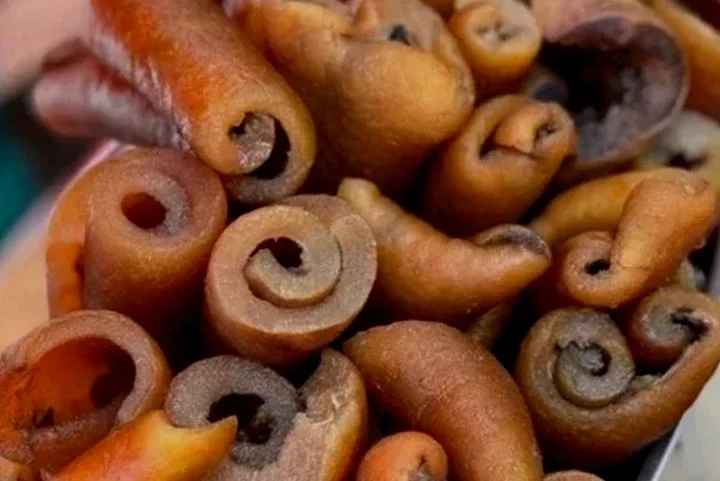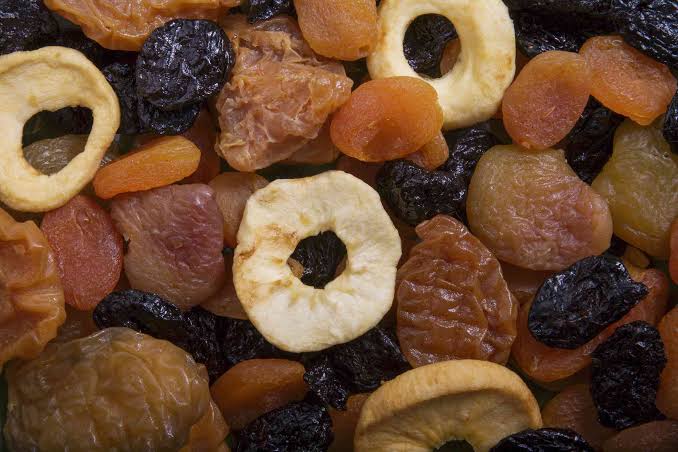Cow Skin is the natural hairy outer covering of the cow which is removed when slaughtered for food. It is also known as cowhide, a by-product of processing cows for meat in the food industry. It is usually earmarked for processing into other things such as durable leather, furniture, belts, bags, rugs/carpets, and accessories.
The skin is viewed as an organ and is well-thought-out to be the largest organ in an animal due to its large surface area. Over the years cow skin is popularly called Ponmo, Kponmo, Pomo, Awo (Nigeria); Kanda, Ngob b Nyam(Cameroon), and dried Kanda (Nigeria).
Pomo is cow skin that has been processed for consumers to cook and eat like beef.
Pomo has become a popular local delicacy loved by all regardless of societal class level. Its unique taste and texture are what make it so popular.
The skin is eaten in other West African countries such as Ghana where it is called welle or wele.
It is equally consumed in the Caribbeans and well-loved by West Indian men in particular.
Pomo is a delicacy that Nigerians love and enjoy especially when added to stews and soups.
100 g of boiled, thick cow skin/hide contains about 224.65 kcal of energy, 6.80 g of carbohydrate, about 43.9 g of water, 46.9 g of protein, 1.09 g of fat, and 0.02 g of fiber Cow hide in itself is really tough to eat and takes time to cook and soften before eating.
Firstly, put a pot with water enough to cover the cow skin over high heat and bring to a boil.
Secondly, allow cooling and then use a sharp knife to remove anything that is on the inside of the cow’s skin.
Similarly, use the knife to scrape the back of the cow’s skin.
Lastly, after cleaning the cow’s skin, discard the water. Put fresh water and allow soaking and light fermentation.
There are three main methods. The first two methods are to remove the hair from the skin and tenderize it while the third method is tanning.
Dark Ponmo
The healthiness of Dark Pomo depends on the type of fire used – wood is generally a minor problem, tires and petrochemicals are a major problem.
In any case, prepared cow skins may be let to soak for some hours in water to get a light fermentation which additionally softens them.
Tanning is the process of treating the skins and hides of animals to produce leather.
Tanning hide into leather involves a process that permanently alters the protein structure of the skin, making it more durable and less susceptible to decomposition, and also possibly coloring it.
There have been a lot of controversies surrounding the nutritional benefits of eating ponmo. This is because not many types of research have been done on it.
Health experts have said that it is harmful and unhealthy with no health benefits but Nigerians disagree.
Pomo is a delicacy that Nigerians love and enjoy and have even turned it into a lucrative business. Ponmo is the number one business in Ijebu-Igbo today.
However, foods with a high level of collagen protein or high gelatin content such as:
Cow skin, pig’s tail, chicken foot, cow leg, oxtail, cow foot, and other gelatinous meats, are seen to be of low biological value (low-quality protein).
This is due to the high levels of non-essential amino acids that they contain and in need of one or more of the essential amino acids.
Also, speculation that it is good for those who want to lose weight since it has no nutritional value is highly debatable.
Above all, the over-consumption of ponmo is affecting the leather industry (as the Nigerian government complained)
The leather industry is suffering from the consumption of ponmo by Nigerians. Instead of these hides being used to make shoes, bags, and wallets, we prefer to eat them.
Ponmo has become a source of livelihood and a good alternative to meat. Perhaps, that’s why Nigeria imports all her leathers.
This has long been a major food item in Nigeria, to the point there is little cowhide left for making leather.
According to Dr. Malik of withdrmalik.org and I quote:
it is wrong to say Kpomo has No nutritional value! It is more correct to say it has low nutritional value when compared to other food sources.
Compared to regular meats, it has low protein and skin collagen. Other nutrients are on the low side too.
But it is a very good dietary roughage – it helps the process of digestion very well.
But, overall, the nutrients are very low except if you supplement them during cooking....Read Full Article [Click Here>]
It is unfair to say that ‘kpomo’ causes cancer. Yes, due to the way it is processed (like using car tyre and fuel to burn it).
There are some chemicals and heavy metals that could cause cancer that is introduced into it.
And, sincerely, these chemicals are in low amounts (to the best of my knowledge) after cooking and preparation.
Kpomo in itself has no cancer-causing ability, the way people process it is the problem.
This is not a problem because kpomo is practically sold in all Nigerian markets at a lower price.
Recipe
– Pomo in a sauce is very tasty and simply amazing!
Cow skin
Cow skin, commonly known as beef tripe, is the edible lining from the stomach of cattle. While it may not be as popular as other cuts of meat, it is consumed in various cuisines around the world.
Here are some potential benefits of cow skin meat:
Rich in Protein:
Like other meat products, cow skin is a good source of high-quality protein. Protein is essential for building and repairing tissues, supporting immune function, and maintaining overall health.
Collagen Content:
Cow skin is rich in collagen, a structural protein that is crucial for maintaining the health of skin, joints, and connective tissues. Collagen is also known to promote skin elasticity and joint flexibility.
Nutrient Density:
Cow skin contains various nutrients, including vitamins and minerals such as iron, zinc, and B vitamins. These nutrients play important roles in various bodily functions, including energy metabolism, immune function, and blood formation.
Potential for Gelatin Production:
Cow skin can be processed to produce gelatin, a substance with various culinary uses. Gelatin is often used in desserts, soups, and various food products. It may also have some health benefits, such as supporting joint health and improving skin condition.
Cultural and Culinary Diversity:
In many cultures, cow skin is used in traditional dishes, adding diversity to the culinary landscape. The preparation and consumption of tripe vary widely, and it is often included in stews, soups, or grilled dishes.
It’s important to note that while cow skin can offer nutritional benefits, it may not be suitable for everyone. Some people may find the taste, texture, or odor unappealing.
Additionally, individuals with certain dietary restrictions or health conditions may need to be cautious about consuming certain animal products.
As with any food, moderation is key, and it’s essential to consider individual preferences and dietary needs.
If you have specific dietary concerns or health conditions, it’s advisable to consult with a healthcare professional or a registered dietitian for personalized advice.
Cow skin meat, also known as beef tripe, is rich in high-quality protein, essential for tissue repair and immune function. It contains collagen, promoting skin and joint health, and provides essential vitamins and minerals such as iron, zinc, and B vitamins.
Collagen is a structural protein found in cow skin meat that supports skin elasticity, joint flexibility, and connective tissue health. Consuming collagen may contribute to improved skin and joint health.
Yes, besides protein and collagen, cow skin meat contains essential nutrients like iron, which is important for blood formation, and zinc and B vitamins that play roles in various bodily functions, including metabolism and immune support.
Absolutely. Cow skin meat is a good source of protein, making it a valuable addition to a diet aiming to meet protein needs. Protein is crucial for muscle maintenance, repair, and overall body function.
Yes, cow skin meat is used in various traditional dishes around the world. It can be included in stews, soups, or grilled dishes, adding cultural diversity to culinary practices.
While cow skin meat has nutritional benefits, individual preferences, and dietary restrictions should be considered. Some people may find its taste or texture unappealing, and individuals with dietary restrictions or health conditions should consult healthcare professionals for personalized advice.
Yes, cow skin can be processed to produce gelatin. Gelatin has culinary uses and may offer benefits such as supporting joint health and improving skin conditions.
Cow skin meat can be part of a balanced diet when consumed in moderation. It can be prepared in various ways, ensuring a diverse and nutrient-rich approach to overall nutrition.
Remember, individual dietary needs vary, and it’s advisable to consult with healthcare professionals or dietitians for personalized advice based on specific health conditions or concerns.





